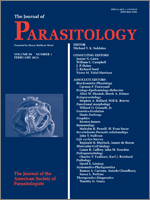The molecular genetic variability of the 12S rRNA gene, on the basis of partial primary sequence and in silico-predicted secondary structures among Dermacentor reticulatus (Fabricius 1794) ticks, was studied in the Chernobyl Nuclear Power Plant (ChNPP) Exclusion Zone. In total, 20, 20, and 25 ethanol-preserved specimens, previously collected at 3 sites with 0.76, 1.91, and 4.5 millisievert (mSv)/hr ionizing radiation background, were examined. The primary sequence analysis generated 4 haplotypes defined by 3 polymorphic sites. The most common haplotype 1 was found in all 3 locations, representing 86.2% of all sampled individuals. Haplotype 4 (10.8%) was detected at the 1.91 and 4.50 mSv/hr sites. The unique haplotypes 2 (1.5%) and 3 (1.5%) were detected only at the 1.91 and 4.50 mSv/hr sites, respectively. The haplotype diversity, nucleotide diversity, and pairwise nucleotide differences for 2 tick populations at the 1.90 and 4.50 mSv/hr sites were 0.279, 0.00085, and 0.289, and 0.397, 0.00122, 0.413, respectively. No polymorphism was detected in ticks collected at the 0.76 mSv/hr site. The primary sequences of 12S rRNA were folded into the secondary structures and the free energy of haplotypes was calculated. The free energy at 37 C (ΔG) of the nonmutant haplotype 1 and the mutant haplotypes 2, 3, and 4 were −45.79, −44.17, −39.56, and −45.79 kcal/mol, respectively. Considering the correlation between the structural profile similarity of 12S rRNA and point mutations, haplotypes 1 and 4 have similar secondary structure profiles and have received a 0.999219 similarity score in the cluster tree. The unique haplotypes 2 and 3 have differences in the secondary structure in comparison with haplotypes 1 and 4; the similarity scores were 0.914747 and 0.169431, respectively. Further studies using more genetic markers are warranted to ascertain the genetic variability and population genetic structure within D. reticulatus tick populations in the ChNPP Exclusion Zone and to resolve their vector capacity.
How to translate text using browser tools
1 February 2013
Genetic Polymorphism of 12S rRNA Gene among Dermacentor reticulatus Fabricius Ticks in the Chernobyl Nuclear Power Plant Exclusion Zone
Alexandru Movila,
Alexandr Morozov,
Natalia Sitnicova
ACCESS THE FULL ARTICLE

Journal of Parasitology
Vol. 99 • No. 1
February 2013
Vol. 99 • No. 1
February 2013




